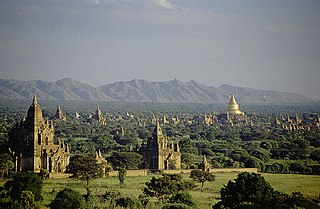| Aleimma အလိမ္မာ | |
|---|---|
| Governor of Martaban | |
| In office c. 1259 –c. 11 January 1285 | |
| Monarch | Narathihapate |
| Preceded by | Nga Shwe |
| Succeeded by | Wareru |
| Personal details | |
| Born | Pagan (Bagan)? Pagan Empire |
| Died | c. 11 January 1285 Thursday, 6th waxing of Tabodwe 646 ME Donwun Pagan Empire |
Aleimma (Burmese : အလိမ္မာ, [ʔəleìmmà] ) was governor of Martaban (Mottama), then a Lower Burma province of the Pagan Empire, from c. 1259 to 1285. Appointed to the office by King Narathihapate, Aleimma proved a loyal governor of the southern province until the 1280s. But when Pagan was fighting a losing war against Mongol invaders in the country's north, he like other vassal rulers in the south began planning to break away. However, the governor himself was assassinated by a local chief named Ma Gadu, who went on to declare independence from Pagan two years later.

The Burmese language is the Sino-Tibetan language spoken in Myanmar where it is an official language and the language of the Bamar people, the country's principal ethnic group. Although the Constitution of Myanmar officially recognizes the English name of the language as the Myanmar language, most English speakers continue to refer to the language as Burmese, after Burma, the older name for Myanmar. In 2007, it was spoken as a first language by 33 million, primarily the Bamar (Burman) people and related ethnic groups, and as a second language by 10 million, particularly ethnic minorities in Myanmar and neighboring countries.

The Kingdom of Pagan was the first kingdom to unify the regions that would later constitute modern-day Burma (Myanmar). Pagan's 250-year rule over the Irrawaddy valley and its periphery laid the foundation for the ascent of Burmese language and culture, the spread of Burman ethnicity in Upper Burma, and the growth of Theravada Buddhism in Burma and in mainland Southeast Asia.
Narathihapate was the last king of the Pagan Empire who reigned from 1256 to 1287. The king is known in Burmese history as the "Taruk-Pyay Min" for his flight from Pagan (Bagan) to Lower Burma in 1285 during the first Mongol invasion (1277–87) of the kingdom. He eventually submitted to Kublai Khan, founder of the Yuan dynasty in January 1287 in exchange for a Mongol withdrawal from northern Burma. But when the king was assassinated six months later by his son Thihathu, the Viceroy of Prome, the 250-year-old Pagan Empire broke apart into multiple petty states. The political fragmentation of the Irrawaddy valley and its periphery would last for another 250 years until the mid-16th century.







